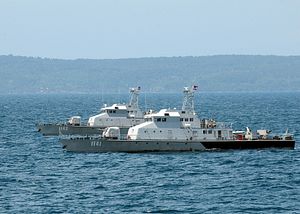Cambodia is holding its first-ever naval training exercise with China this week as regional anxieties rise over Beijing’s activities in the South China Sea.
As The Diplomat reported earlier this week, three Chinese warships docked at Cambodia’s Sihanoukville port on February 22 on a five-day visit – the first time that Chinese warships had paid a port visit there (the two previous visits involved a training ship in 2008 and China’s Peace Ark hospital ship in 2013) (See: “Chinese Warships Visit Thailand, Cambodia on Goodwill Tour”). Ahead of the port visit, both Chinese and Cambodian officials said that it would include military exchanges, friendly football matches, as well as a joint drill.
According to Cambodia’s deputy navy chief Vice Admiral Vann Bunneang, 70 Cambodian sailors will join 737 of their Chinese counterparts for what he said would constitute the first and biggest-ever naval training exercise with Beijing. The exercises, which take place on Wednesday and Thursday, cover rescue activities and emergencies at sea.
“This will be a big cooperation and joint exercise training in rescue operations,” he told Reuters. “This is to boost readiness for when boats sink and natural disasters occur.”
China already has a strong defense relationship with Cambodia, one of Beijing’s key partners in Southeast Asia. As I have noted before, China is the largest donor of military aid to Cambodia, and defense ties have been strengthening over the past few years (See: “Why is a Big Cambodia Military Delegation in China?”) The boosting of ties in the naval domain is thus only the latest step in the development of bilateral defense relations.
Advancing defense ties would seem to be in the interest of both sides: Phnom Penh gets much-needed boosts to its military capabilities, while Beijing gets a strong Asian partner that supports key Chinese initiatives and positions. Yet Cambodia’s dependence on Beijing has also led it to firmly support China even where its actions have clearly undermined regional peace and security as with the South China Sea issue (See: “Cambodia: A New South China Sea Mediator Between China and ASEAN?”) As I have noted previously, to many close observers, the most vivid illustration of this came in July 2012 when an ASEAN summit held in Phnom Penh failed to issue a joint communique for the first time, an event some attributed to Cambodian officials being pressured by its largest trading partner and investor on the South China Sea issue (See: “ASEAN’s Soul Searching After Phnom Penh”).
The China-Cambodia exercise comes amid renewed concerns about Beijing’s assertiveness in the South China Sea. Last week, China deployed an advanced surface-to-air missile system on Woody Island, one of the disputed Paracel islands in the northern half of the South China Sea. And on Monday, the eve of Chinese foreign minister Wang Yi’s visit to the United States, satellite imagery released by the the CSIS Maritime Transparency Initiative showed Beijing had built what could be a high-frequency radar system on Cuarteron reef in the Spratlys in the southern portion of the South China Sea
When asked whether China was using the exercise as an opportunity to flex its military muscle, the Cambodian officer said rather candidly that this would not be out of the ordinary.
“It is like a clothing company: After they make a new product, they often advertise. So the presence of Chinese warships in Cambodia or other places is because China is a big country and wants to show off to the world their modern technology,” he said.
The exercise with China also notably came just over a day after the scheduled departure of three vessels from the Japan’s Maritime Self-Defense Force holding cultural exchanges with Cambodian navy personnel, a point some Cambodian officials were keen to highlight to suggest that Phnom Penh still continues to seek balance in its external relationships rather than being overly dependent on Beijing.

































